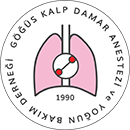

Cilt: 17 Sayı: 1 - 2011
| DERLEME | |
| 1. | Kardiyovasküler Cerrahide Nöromüsküler Monitörizasyon Neuromuscular Monitoring in Cardiovascular Surgery Süheyla Ünver, Sema Şanaldoi: 10.5222/GKDAD.2011.001 Sayfalar 1 - 4 Hastaların nöromüsküler bloke edici ajanlara (NMB) duyarlılıkları farklı olduğu için nöromüsküler bloke edici ajan alan tüm hastalar monitorize edilmelidir. Periferik sinir stimulatöründen sağlanan bilgiler; etkinin başlama zamanının belirlenmesinde, nöromüsküler (NM) blokajın titrasyonunda yol göstermede, ilaçla hızlandırılmış antagonizmaya başlama için en uygun zamanı anlamada ve bu antagonizmanın yeterliliğini ortaya koymakta kullanılır. Nöromüsküler fonksiyonun derecesini belirlemede sıklıkla elektriksel uyarılar kullanılır. Genellikle gözle veya muayene yoluyla kasın sinir sitimulasyonuna verdiği yanıt veya kliniği değerlendirilir. Günümüzde klinik kullanımda ticari olarak bulunan basit ve güvenilir bir yöntem olan akseleromiyografi bu amaçla kulanılmaktadır. Göz çevresindeki kaslar, Orbicularis Oculi ve Corrugatör supercili, larenks kaslarının gevşemesini diğer kaslara göre daha iyi yansıtırlar. Bu nedenle entübasyon koşullarının yeterliliğini belirlemede iyi bir seçenek olabilir. Adductor Pollicis Longi ve üst solunum yollarının kasları da NMBlere en hassas kaslardır ve bloğun geri dönmesi en uzun sürenlerdendir. Ekstübasyon için de bu kasın monitorizasyonu daha uygundur. Son yirmi yılda kalp cerrahisinde büyük ilerlemeler elde edilmiştir. Anestezideki gelişmelerde sıklıkla cerrahi koşullardaki değişmeye bağlıdır. Kalp cerrahisinde NM blokajın sağlanması ve takibinde NM monitorizasyonun önemli yer tuttuğu durumlar: 1) Diyafragmanın tam hareketsizliğinin gerektiği, tek akciğer ventilasyonun uygulandığı, dolayısıyla yüksek dozlarda NMBlerin kullanıldığı, sık tekrarlanan kas gevşetici dozları veya infüzyonla NMB verilen hastalar. 2) Kalp cerrahisi sonrası hızlı ekstübasyon (1-6 saat) planlanan olgular, 3) Postoperatif dönemde ekstübasyonu geciktiren rezidüel paralizinin varlığının ortaya konulması ve önlemesinin gerektiği durumlardır. |
| ARAŞTIRMA | |
| 2. | Düşük Soluk Hacimlerinin Tek Akciğer Ventilasyonunda Oksijenasyon Üzerine Etkileri Effects of Lower Tidal Volumes on Oxygenation During One-Lung Ventilation Zerrin Sungur Ülke, Birsen Köse, Emre Çamcı, Ayşen Yavru, Kemalettin Koltka, Alper Toker, Şükrü Dilge, Mert Şentürkdoi: 10.5222/GKDAD.2011.005 Sayfalar 5 - 11 AMAÇ: Tek akciğer ventilasyonu (TAV) esnasında çift akciğer ventilasyon sürecine benzer soluk hacmi uygulanması önerilmektedir. Öte yandan yeni çalışmalar düşük soluk hacmi kullanımının, daha az enflamasyon yanıtı ile birlikte olduğunu göstermektedir. Bu çalışmanın amacı TAV sırasında geleneksel yüksek soluk hacim yaklaşımı ile azaltılmış soluk hacmi (TV) uygulamasının oksijenasyon üzerine etkilerini karşılaştırmaktır. YÖNTEMLER: Elektif akciğer rezeksiyonu planlanan 31 hastaya TAV sırasında iki farklı ventilasyon modeli, iki bölüm halinde basınç kontrollü modda uygulandı. Çift akciğer ventilasyonunda (ÇAV) normokapniyi sağlayacak TV ayarlandı. Sonrasında TAV sırasında ya normokarbiyi sağlayacak TV korunarak (normokarbik evre; EN) ya da basınç korunup hiperkarbiye izin vererek yapay solunum sürdürüldü (hiperkarbik evre; EH). Çalışmanın her iki evresi tüm olgularda iki aşamalı olarak uygulandı. Her aşamada PaO2, PaCO2, TV ve Qs/Qt kaydedildi. BULGULAR: Çalışmamızda EHde ENye göre TV değerleri anlamlı olarak düşük (sırasıyla 399±136 mL ve 569±180 mL; p<0.001) bulunurken PaCO2 değerleri EHde anlamlı olarak yüksek (46±7.6 mmHg ve 39.1±6.2 mmHg vs; p<0.001) bulunmuştur. Yine EHde PaO2 değerleri bir miktar düşük seyretmiş, ancak bu düşüklük istatistiksel anlamlılık göstermemiştir. Benzer şekilde Qs/Qt oranında iki evre arasında anlamlı fark gözlenmemiştir. SONUÇ: Düşük TV uygulaması TAV sırasında oksijenasyonda ciddi değişikliğe yol açmadığından, çekincesiz olarak kullanılabilir. |
| OLGU SUNUMU | |
| 3. | Sağ Taraflı Çift Lümenli Tüp ile Sol Endobronşiyal Entübasyon Left Endobronchial Intubation with a Right-Sided Double Lumen Tube (A Case Report) Hasan Hepağuşlar, Ayşe Pelin Girgin, Ulaş Pınar, Zahide Elardoi: 10.5222/GKDAD.2011.012 Sayfalar 12 - 14 Tek akciğer ventilasyonu, torakal cerrahi girişimler sırasında genellikle uygulanan bir tekniktir. Bu olgu sunumunda, yeniden şekil verilen sağ-taraflı çift lümenli tüp (ÇLT) ile gerçekleştirilen sol endobronşiyal entübasyon uygulaması sunuldu. Akciğer kanseri nedeniyle 60 yaşında erkek olguya sağ üst lobektomi planlandı. Cerrahi girişim günü uygun çapta sol-taraflı ÇLTün mevcut olmaması nedeniyle, sağ-taraflı ÇLTye iki kademeli manevra ile sol-taraflı ÇLT benzeri şekil verildi ve bu ÇLT kullanılarak sol endobronşiyal entübasyon gerçekleştirildi. Cerrahi girişim sorunsuz tamamlandı. Olgu yoğun bakım ünitesine spontan solunumda transport edildi. Bir gün yoğun bakımda kalan olgu daha sonra servise çıkarıldı. |
| 4. | Bronkojenik Kistlerde Cerrahi Tedavi ve Anestezi Yönetimi Surgical Treatment and Management of Anaesthesia in Bronchogenic Cysts Mesut Erbaş, Sami Karapolat, Suat Gezer, Havva Erdem, Talha Dumlu, Hakan Ateşdoi: 10.5222/GKDAD.2011.015 Sayfalar 15 - 20 Giriş: Bronkojenik kistler embriyolojik dönemde trakeobronşiyal sistemin anormal gelişmesi sonucu meydana gelen ve genellikle akciğer parankimi veya mediasten yerleşimli olan lezyonlardır. Olgu sunumları: Radyolojik tetkikler sonucunda tespit edilen 3 erkek ve 2 kadın bronkojenik kist olgusu kliniğimizde takip edilmiştir. Bronkojenik kistler olgulardan 3ünde mediastinal, 1inde intraparankimal ve 1inde ise jugulum bölgesinde cilt altı yerleşimliydi. Dört olguda tek akciğer ventilasyonunun uygulandığı standart posterolateral torakotomi insizyonu 1 olguda ise lokal anestezi altında jugulumda yapılan horizontal kesi ile kistik yapı duvar ve epitelinin tamamını içerecek şekilde total olarak rezeke edildi. Torakotomi uygulanan olgularda postoperatif dönemde hasta kontrollü analjezi yöntemi ile etkili bir analjezi sağlandı. Histopatolojik inceleme ile bronkojenik kist tanısı konulan olguların tümü sorunsuz olarak taburcu edildi. Olgular 6 ay-2 yıl arasında takip edilmiş ve hiçbirisinde uzun dönemli komplikasyon ve nüks görülmemiştir. Sonuç: Bronkojenik kistlerin cerrahi komplet rezeksiyonu hem kesin patolojik tanının konulmasını hem de tam kür elde edilmesini sağlamaktadır. Etkin bir anestezi yönetimi ve postoperatif hasta kontrollü analjezi uygulamaları olguların konforlarını artırmakta ve iyileşme sürecini hızlandırmaktadır. |
| 5. | Torakal Epidural Anestezi Eşliğinde Bül Rezeksiyonu Resection of Bullae Under Thoracic Epidural Anesthesia Mustafa Şimşek, Mensure Çakırgözdoi: 10.5222/GKDAD.2011.021 Sayfalar 21 - 23 Kronik obstrüktif akciğer hastalığı (KOAH), toraks dışı cerrahi girişimlerde anestezi uygulamasındaki önemli risk faktörlerinden biridir. Göğüs cerrahisinde bu risk belirgin olarak artmaktadır. KOAHlı hastalarda hem operasyon sırasında hem de postoperatif dönemde atelektazi, pnömoni gibi komplikasyonlar sık görüldüğünden anestezi yaklaşımı oldukça önemlidir. Burada sağ akciğerde amfizem, sağ hemitoraksta pnömotoraks ve kalp fonksiyonları bozulmuş olan, torakal epidural anestezi kullanılarak bül rezeksiyonu yapılan 70 yaşındaki erkek hasta sunulmuştur. |

















